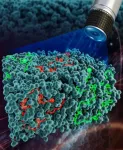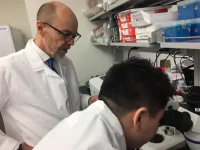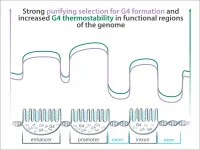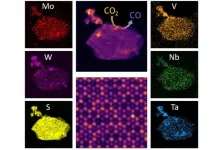(Press-News.org) University of Colorado Boulder researchers have discovered that minuscule, self-propelled particles called "nanoswimmers" can escape from mazes as much as 20 times faster than other, passive particles, paving the way for their use in everything from industrial clean-ups to medication delivery.
The findings, published this week in the Proceedings of the National Academy of Sciences, describe how these tiny synthetic nanorobots are incredibly effective at escaping cavities within maze-like environments. These nanoswimmers could one day be used to remediate contaminated soil, improve water filtration or even deliver drugs to targeted areas of the body, like within dense tissues.
"This is the discovery of an entirely new phenomenon that points to a broad potential range of applications," said Daniel Schwartz, senior author of the paper and Glenn L. Murphy Endowed Professor of chemical and biological engineering.
These nanoswimmers came to the attention of the theoretical physics community about 20 years ago, and people imagined a wealth of real-world applications, according to Schwartz. But unfortunately these tangible applications have not yet been realized, in part because it's been quite difficult to observe and model their movement in relevant environments--until now.
These nanoswimmers, also called Janus particles (named after a Roman two-headed god), are tiny spherical particles composed of polymer or silica, engineered with different chemical properties on each side of the sphere. One hemisphere promotes chemical reactions to occur, but not the other. This creates a chemical field which allows the particle to take energy from the environment and convert it into directional motion--also known as self-propulsion.
"In biology and living organisms, cell propulsion is the dominant mechanism that causes motion to occur, and yet, in engineered applications, it's rarely used. Our work suggests that there is a lot we can do with self-propulsion," said Schwartz.
In contrast, passive particles which move about randomly (a kind of motion known as Brownian motion) are known as Brownian particles. They're named after 19th century scientist Robert Brown, who studied such things as the random motion of pollen grains suspended in water.
The researchers converted these passive Brownian particles into Janus particles (nanoswimmers) for this research. Then they made these self-propelled nanoswimmers try to move through a maze, made of a porous medium, and compared how efficiently and effectively they found escape routes compared to the passive, Brownian particles.
The results were shocking, even to the researchers.
The Janus particles were incredibly effective at escaping cavities within the maze--as much as 20 times faster than the Brownian particles--because they moved strategically along the cavity walls searching for holes, which allowed them to find the exits very quickly. Their self-propulsion also appeared to give them a boost of energy needed to pass through the exit holes within the maze.
"We know we have a lot of applications for nanorobots, especially in very confined environments, but we didn't really know how they move and what the advantages are compared to traditional Brownian particles. That's why we started a comparison between these two," said Haichao Wu, lead author of the paper and graduate student in chemical and biological engineering. "And we found that nanoswimmers are able to use a totally different way to search around these maze environments."
While these particles are incredibly small, around 250 nanometers--just wider than a human hair (160 nanometers) but still much, much smaller than the head of a pin (1-2 millimeters)--the work is scalable. This means that these particles could navigate and permeate spaces as microscopic as human tissue to carry cargo and deliver drugs, as well as through soil underground or beaches of sand to remove unwanted pollutants.
Swarming nanoswimmers
The next step in this line of research is to understand how nanoswimmers behave in groups within confined environments, or in combination with passive particles.
"In open environments, nanoswimmers are known to display emergent behavior--behavior that is more than the sum of its parts--that mimics the swarming motion of flocks of birds or schools of fish. That's been a lot of the impetus for studying them," said Schwartz.
One of the main obstacles to reaching this goal is the difficulty involved in being able to observe and understand the 3D movement of these tiny particles deep within a material comprising complex interconnected spaces.
Wu overcame this hurdle by using refractive index liquid in the porous medium, which is liquid that affects how fast light travels through a material. This made the maze essentially invisible, while allowing the observation of 3D particle motion using a technique known as double-helix point spread function microscopy.
This enabled Wu to track three-dimensional trajectories of the particles and create visual representations, a major advancement from typical 2D modeling of nanoparticles. Without this advancement, it would not be possible to better understand the movement and behavior of either individuals or groups of nanoswimmers.
"This paper is the first step: It provides a model system and the imaging platform that enables us to answer these questions," said Wu. "The next step is to use this model with a larger population of nanoswimmers, to study how they are able to interact with each other in a confined environment."
INFORMATION:
Benjamin Greydanus of the Department of Chemical and Biological Engineering at CU Boulder is a co-author of this publication.
Research from the McKelvey School of Engineering at Washington University in St. Louis has found a missing piece in the puzzle of optical quantum computing.
Jung-Tsung Shen, associate professor in the Preston M. Green Department of Electrical & Systems Engineering, has developed a deterministic, high-fidelity two-bit quantum logic gate that takes advantage of a new form of light. This new logic gate is orders of magnitude more efficient than the current technology.
"In the ideal case, the fidelity can be as high as 97%," Shen said.
His research was published in May 2021 in the journal Physical Review A.
The potential of quantum computers is bound to the unusual properties of superposition -- the ability of a quantum system to contain many distinct properties, or states, ...
Irvine, Calif., June 29, 2021 - Fireworks are synonymous in the United States with the celebration of Independence Day and other special events, but the colorful displays have caused a growing risk to public safety in recent years, according to a study by environmental health researchers at the University of California, Irvine.
Relying on real-time air quality measurements crowdsourced from a network of more than 750 automated sensors distributed throughout California, scientists from UCI's Program in Public Health found that short-term, extremely high-particulate-matter air pollution from the widespread ...
This lobster tale begins a few years ago when the proprietor of a northeastern seafood restaurant publicly asserted that exposing lobsters to a little cannabis prior to cooking produced notable changes in their behavior and a less dramatic scene in the kitchen for all concerned, which was the Maine thing.
In a paper published online June 29, 2021 in the journal Pharmacology Biochemistry and Behavior, a team led by researchers at University of California San Diego School of Medicine, report on efforts to answer that burning, boiling and baked question. They obtained live lobsters (Homarus americanus) from a supermarket and exposed the crustaceans to up to 60 minutes of vaporized Δ9-tetrahydrocannabinol (THC) -- the principle psychoactive component of cannabis -- then ...
June 29, 2021 - Nutley, NJ - Scientists from the Hackensack Meridian Center for Discovery and Innovation, working with collaborators from across the globe, uncovered the mechanism of action of a novel anti-tuberculosis drug that they have helped develop.
The new findings show how the enzyme inhibitor triaza-coumarin, or TA-C, is metabolized by the TB germs, which makes it effective in inhibiting the disease from within, like in a "Trojan horse" attack, according to the new paper in the journal Proceedings of the National Academy of Sciences.
"This is a promising new direction of research," said Thomas Dick, member of the CDI faculty. "We are hoping this work can make a difference in the ongoing fight against TB."
"The scientists at the CDI who specialize in ...
For many years, researchers have been focused on developing technologies that can help us fight the imminent climate change crisis. They have one goal in common: finding sustainable energy sources that can replace the environmentally toxic fossil fuels. "Photocatalysts" that drive an artificial process that replicates photosynthesis (in which solar energy is converted to useful materials) are promising in this regard, given that we are able to develop the technology needed for them. Crystalline materials, such as strontium titanate (SrTiO3), which can serve as "photocatalysts" in solar devices, can lead us in the direction.
SrTiO3 is attractive owing to various other reasons ...
Basic needs of disaster- and conflict-impacted refugees are often met by humanitarian relief goods and services, and until now little was known about how refugees create economic livelihood beyond immediate relief.
A new exploratory case study from Portland State University Associate Professor of Management Theodore Khoury reveals how Syrian refugees in the Za'atari camp reached beyond basic disaster relief support and leveraged social capital to create informal economic systems that helped improve their quality of life. The study, "Towards a theory of informal supply networks: An?exploratory case study of the Za'atari refugee camp," is published in the Journal of Operations Management and co-authored by ...
PHILADELPHIA - The use of e-cigarettes, or vaping, causes serious damage to the lungs. After the novel coronavirus responsible for the respiratory disease COVID-19 emerged last year, there have been ongoing concerns about how vaping might impact risk of infection and severity of symptoms. Some evidence shows an increased risk of COVID-19 among those who vape. Research also shows a higher COVID-19 mortality rate in men compared to women, and men are more likely to vape than women. However, there is no evidence to link these two observations.
New research from Jefferson sheds light on this by showing that exposure to e-cigarette vapor increases levels of the coronavirus receptor in the lungs ...
A 50% rise in the level of carbon dioxide (CO2) in the atmosphere could reduce rainfall in the Amazon as much as or even more than substitution of the entire forest by pasture. The rise in CO2 would reduce the amount of water vapor emitted by the forest, leading to a 12% annual drop in the volume of rainfall, while total deforestation would reduce rainfall by 9%.
These estimates are presented in a study published in Biogeosciences by scientists affiliated with the National Space Research Institute (INPE), the University of São Paulo (USP) and the University of Campinas (UNICAMP) in Brazil, and with Munich Technical University (TUM) in Germany.
“CO2 is a basic input for photosynthesis, so when it increases in the atmosphere, plant physiology ...
Some regions of the human genome where the DNA can fold into unusual three-dimensional structures called G-quadruplexes (G4s) show signs that they are preserved by natural selection. When G4s are located in the regulatory sequences that control how genes are expressed or in other functional, but non-protein coding, regions of the genome, they are maintained by selection, are more common, and their unusual structures are more stable, according to a new study. Conversely, the structures are less common, less stable, and evolve neutrally outside of these regions, including within the protein-coding regions of genes themselves.
Together, these ...
A two-dimensional alloy material -- made from five metals as opposed to the traditional two -- has been developed by a collaboration between researchers at the McKelvey School of Engineering at Washington University in St. Louis and researchers at the College of Engineering at the University of Illinois at Chicago.
And, in a first for such a material, it has been shown to act as an excellent catalyst for reducing CO2, into CO, with potential applications in environmental remediation.
The research, from the lab of Rohan Mishra, assistant professor in the Department of Mechanical Engineering & Materials Science at ...






